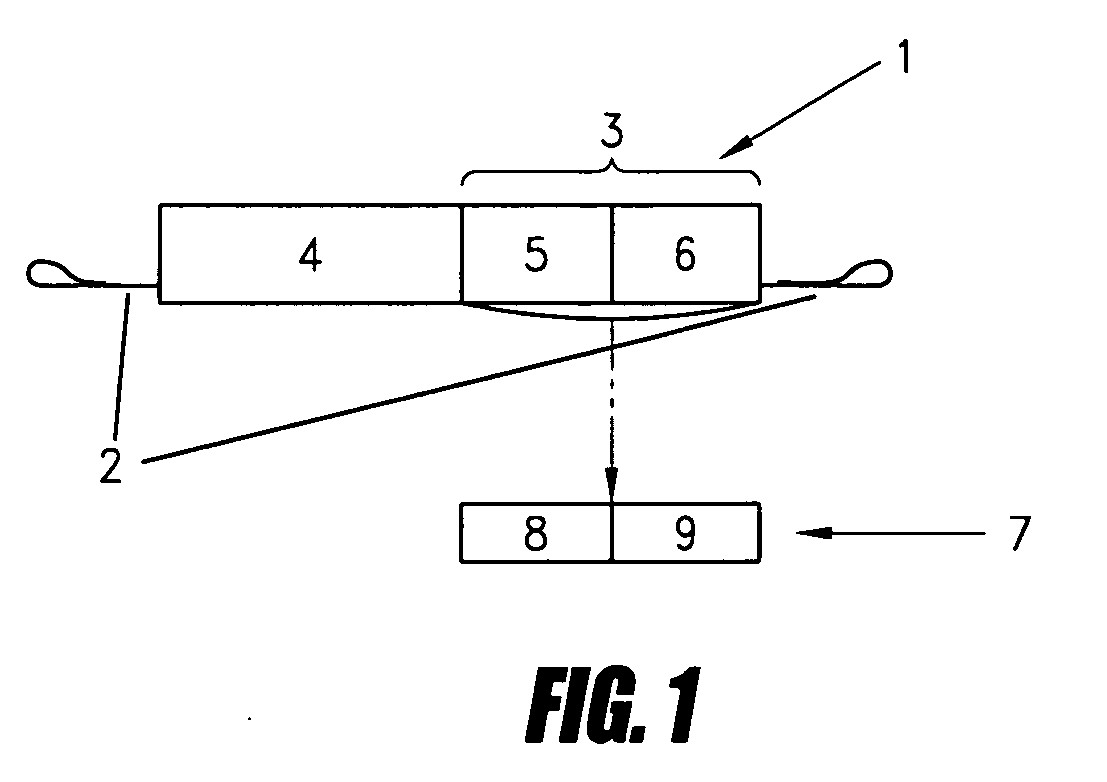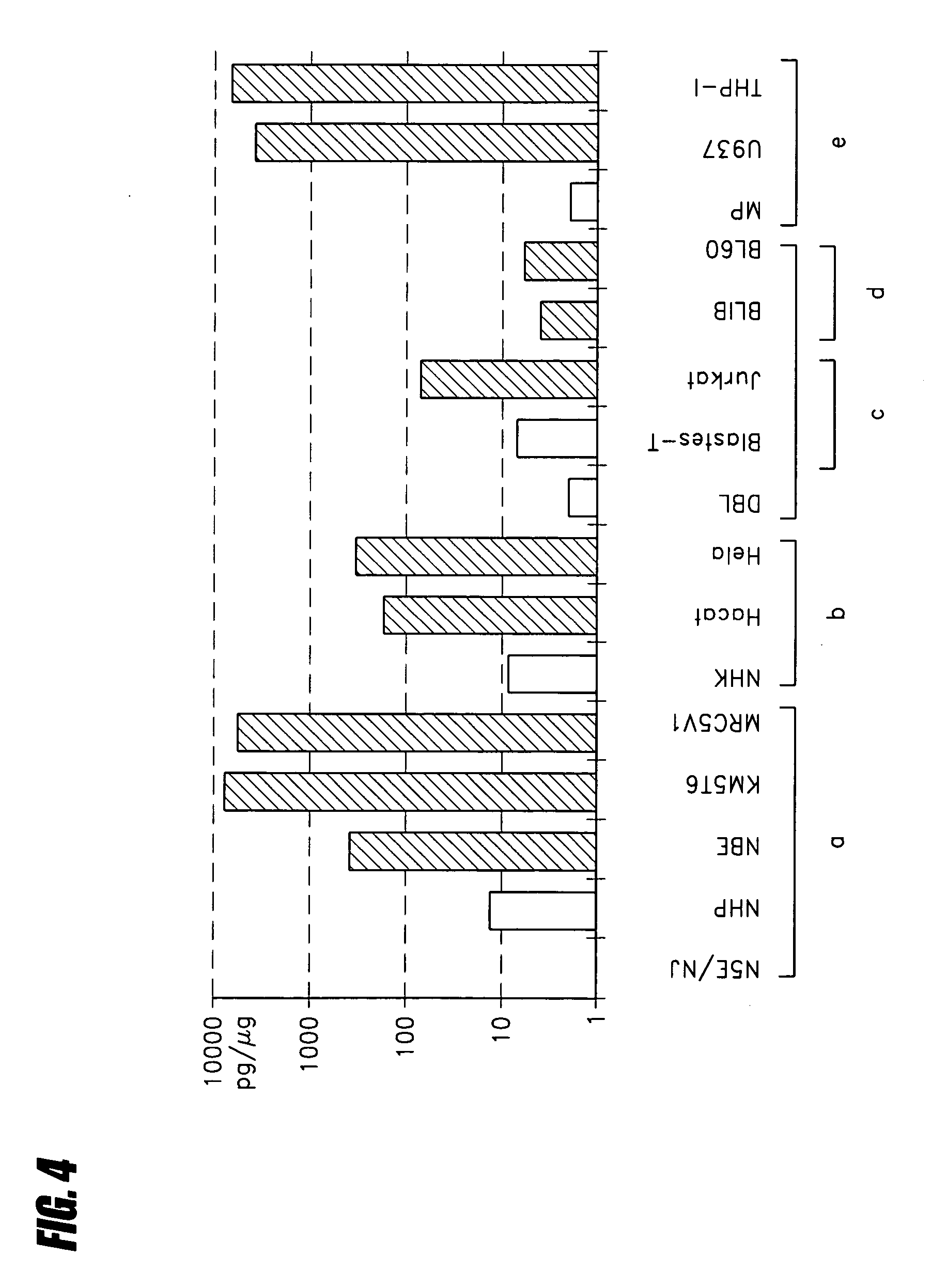Nucleotide sequence for treating cancer and infection
- Summary
- Abstract
- Description
- Claims
- Application Information
AI Technical Summary
Benefits of technology
Problems solved by technology
Method used
Image
Examples
example 1
Treatment of H.I.V. Infection
[0136] The viral sequences used are, on the one hand, the 5′LTR sequence of HIV modified so as to be controlled by the HIV TAT protein and so as to escape control by cellular transactivation factors, and on the other hand, the RRE sequence placed under the control of the HIV Rev protein and linked to the adjacent CRS sequence. The effector sequence placed between these two sequences consists of the gene encoding fragment A of diphtheria toxin. These two sequences impose a double safety on the expression of the A fragment which can only occur in the cells infected by HIV which produce (even at low noise such as in latent infections) both the TAT and REV proteins. The TAR sequence (controlled by TAT) and the RRE sequence (REV responsive element) from HIV-1 respond to the TAT and REV proteins from HIV-1 and HIV-2 as well as to the TAX and REX proteins from HTL-V-1. The high degree of conservation of these sequences makes it possible to treat cells infected...
example 2
Treatment of Breast Cancer
Process for the Production of the Vector Construct
1. Isolation of the Transactivable Regulatory Sequence
[0151] Amplification by PCR of the fragment [0152] GAG Hind III-H23 Ag (280)-H23 Ag (784)-EcoRI-GAG of 584 base pairs of the 5′ flanking sequence of H23 Ag (ATG in 785) from the genomic DNA of the human mammary cancer line (T47D). [0153] Digestion with HindIII and EcoRI and insertion into the HindIII (689) and EcoRI (701) sites of the plasmid pIBluescript SK + / −.
2. Isolation and Integration of the Cisactivable Effector Sequence [0154] Amplification by PCR of the fragment [0155] GAG EcoRI-ATG Diphtheria Toxin DTA (79-653) TAG-XbaI-GAC fragment encoding the toxic portion ofthe diphtheria toxin lacking the “hydrophobic leader signal sequence” by the primer GAG EcoRI ATG-DTA (79-100) and by the primer DTA (631-653)-TAG-XbaI-GAG [0156] Digestion with EcoRI and XbaI and insertion of the DTA fragment into the EcoRI (701) and XbaI (731) sites of the plasmi...
example 3
Vector Construct to be Used for the Treatment and Diagnosis of Cancer (Breast Cancer)
1. Isolation of the Transactivable Regulatory Sequence
[0161] The amplification by PCR of the fragment GAG HindIII-H23 Ag (280)-H23 Ag (784)-EcoRI-GAG and its insertion at the HindIII (689) and EcoRI (701) sites of the plasmid pBluescript SK + / − is performed as above.
2. Isolation and Integration of the Cisactivable Effector Sequence [0162] Amplification by PCR of the fragment [0163] GAG EcoRI-ATG-HSV-1 Thymidine kinase (59 to 1189) TGA XbaI-GAG [0164] Insertion at the EcoRI (701) and XbaI (731) sites of the plasmid pBluescript SK + / − containing the H23 Ag fragment.
3. Integration of the Effector Sequence and of its Regulatory Sequence into the Parvoviral Vector [0165] Insertion of the fragment H23 -Tk into the HindIII (2650) and XbaI (4339) sites of the plasmid pMM 984. [0166] Synthesis of iodovinyldeoxyuridine labeled with 123Iodine for the treatment and detection, using a gamma camera, of can...
PUM
| Property | Measurement | Unit |
|---|---|---|
| Fraction | aaaaa | aaaaa |
| Sensitivity | aaaaa | aaaaa |
| Cytotoxicity | aaaaa | aaaaa |
Abstract
Description
Claims
Application Information
 Login to View More
Login to View More - R&D Engineer
- R&D Manager
- IP Professional
- Industry Leading Data Capabilities
- Powerful AI technology
- Patent DNA Extraction
Browse by: Latest US Patents, China's latest patents, Technical Efficacy Thesaurus, Application Domain, Technology Topic, Popular Technical Reports.
© 2024 PatSnap. All rights reserved.Legal|Privacy policy|Modern Slavery Act Transparency Statement|Sitemap|About US| Contact US: help@patsnap.com










